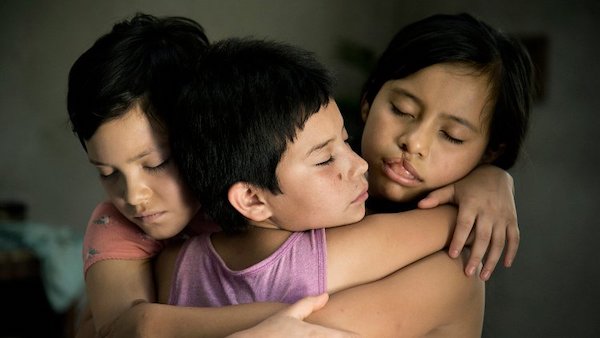Film Review: “Prayers for the Stolen,” A Microcosm of Mexico, Makes US Premiere at the NY Film Festival
By David D’Arcy
Let’s see if Prayers for the Stolen is selected as Mexico’s Academy Award nominee. It’s a long shot, given that this is a film that tells so much of the truth.

A scene from Prayers for the Stolen.
The story of a young girl in an isolated Mexican village struggling to grow up as forces from outside tear her tiny community apart, Prayers for the Stolen (“Noche de Fuego” in Spanish) is one of the most compelling discoveries at this year’s New York Film Festival.
The film is the first fictional feature by Tatiana Huezo, who until now has made documentaries. Prayers for the Stolen may be a feature, but it builds on grim realities. Set in a narrow valley hemmed in by steep hills, the location is as breathtaking as the future for young Ana (Ana Cristina Ordonez Gonzalez) is horrifying.
The village has few men, besides those who arrive in big black vehicles to exploit it. Most males, including Ana’s father, are working in the United States. At night, a hillside sparkles, not with fireflies but with the lit screens of cell phones, as local women try to capture the best signals for their conversations. The women ask their men all over the US to call them, so the families, who survive in the village on nickels and dimes and cash sent from abroad, won’t have to pay.
Work can be found near the village, but none of it pays much. We watch as a wooded mountainside, which could be on the cover of a tourist brochure, is dynamited away. The stone, used for the building trades, is carried off to trucks by children, local boys. The villagers’ own houses are made out of whatever scrap that the women can salvage.
Some of the local employment is mandatory. Women are picked up, loaded into trucks, and taken to fields where they scrape off the paste that grows on poppies. It will be cultivated for heroin. The narco-agribusiness appears to be an efficient and accepted part of the local economy; the soldiers who drive by aren’t doing much to stop it.
Nor do the soldiers do much to stop another local industry, the kidnapping of young girls to be trafficked. Ana’s mother Rita (Mayra Batalla) cuts the girl’s hair short to discourage male attention. (Predators leave a girl with a harelip alone.) Rita’s husband, who might have done something to defend the family, no longer calls from the US. The teacher in the village school, another protector, disappears. As black pickup trucks roar through the streets, Rita hides Ana in a hole she digs in their house’s dirt floor.
Fear rules the village even before the narcos arrive in their trucks. Young girls, as they share secrets and dance, learn to sense what the older women in the town know. Their home, in the shadow of dark mountains, is a prison. The alternative, escape, amounts to being carried off in one of the black vehicles.
Director Huezo’s last documentary, Tempestad, premiered at the Berlin International Film Festival in 2016. The film followed two women. Miriam was just released from prison, in the latest (probably not the last) stage of a nightmare that began with an arrest on false charges and led to torture, confinement, and a huge bribe paid by relatives to get her out. Adela, the other woman whom Tempestad follows, is haunted by the kidnapping of her daughter.
Prayers for the Stolen, which took nine months to shoot, is a drama about a child’s life that can’t be sheltered. In her first dramatic film, Huezo’s skill at directing actors is discreet, but effective. All of the children, including inquisitive young Ana, seen in two stages of her childhood (Marya Membreño plays Ana entering adolescence) are played by non-professionals. Their acting is remarkably credible, maybe because the script requires young girls to perform in situations that are tragically familiar to all. It would be hard to rehearse the furtive reaction shots that sustain the tension of this troubling film. And it’s even harder to fake them.
Prayers for the Stolen was inspired by the 2014 novel of the same name by Jennifer Clement, an American writer who lives in Mexico and writes in English. That story is narrated by a child named LadyDi who seems to see everything. Huezo’s film script renames her Ana and shifts the story away from her dreams and toward life around her, which doesn’t lack for visceral conflict or a paradoxically chilling rural claustrophobia. (Those seeking more on the epidemic of trafficking in Mexico, which has worsened as more women head to the US border on their own, can find it in She Migrates, an informative report on Latino USA, a show heard on NPR.)
As the topical Prayers for the Stolen makes its US premiere, its narrative is eclipsed in the American media by the Haitian migration north through Latin America, with staggering images of mothers and children trekking through the Darien Gap or being herded at the US-Mexico border by men on horseback. In her film, Huezo keeps her frame narrow; she cuts away from fraught village scenes to footage of majestic hills dynamited into stones that might end up lining some American’s driveway. Let’s see if Prayers for the Stolen is selected as Mexico’s Academy Award nominee. It’s a long shot, given that this is a film that tells so much of the truth.
David D’Arcy, who lives in New York, writes about art for many publications, including the Art Newspaper. He produced and co-wrote the documentary Portrait of Wally (2012), about the fight over a Nazi-looted painting found at the Museum of Modern Art in Manhattan.
